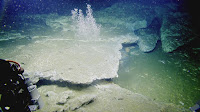For the past two years, scientists from Oregon State University and the National Oceanic and Atmospheric Administration (NOAA) have surveyed the Pacific Northwest near-shore region mapping sites where underwater bubble streams signify methane gas is being released from the seafloor.
And what they have found is eye-opening. Since the first evidence of underwater methane was discovered in the late 1980s, only about 100 "seep sites" had been identified along the Northwest coast through 2015. They often were discovered by accident, when fishermen would spot anomalies on their fish-finders that turned out to be acoustic reflections of the bubbling methane gas.
But over the past two years the scientists -- aided by new sonar technology on the Exploration Vessel (E/V) Nautilus, owned and operated by the Ocean Exploration Trust -- have purposefully gone seeking evidence of underwater methane and have expanded the total number of offshore seep emission sites to a whopping 1,000 locations.
It is not yet clear whether the methane presents an opportunity for a new source of energy or a potentially serious environmental threat, but for now the researchers want to map the distribution of the sites and conduct research on the composition and sources of the gas. They believe they will discover new methane seeps this summer when they utilize several research vessels to conduct additional mapping off the Northwest coast.
Read more at Widespread Methane Seeps Off Oregon Coast

No comments:
Post a Comment